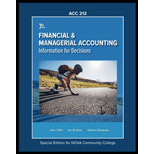
General accounting principle:
This contains the accounting principal generally used in every corporation. This is based on the economic condition of country and differs from one country to another.
Cost concept:
As per this concept, actual value of the assets is recorded in the
Business entity assumption:
The business entity concept means that the business man should record the business transaction and personal transaction separately. Each form of business organization is a separate business entity. So the accountant will record the personal and business transaction separately.
Revenue recognition principle:
Revenue recognition principle provides the rules and regulation that should be followed while recognizing the revenue. In accrual basis of accounting the accountant record the transaction of sales when it occurs not when the payment against sale is received.
Specific accounting principle:
The specific principle is specific in nature. Means they differ from one company to another. They are based on the type of business, nature of business, scale of business and many more factors.
Matching (expense recognition) principle:
As per this accounting principle the expense occurs to initiate sales must be recorded in the same accounting period. If the expenses occur not directly relates to the sales period than it should be expense incurred.
Going concern assumption:
As per this concept the life of the company is not defined. As the company is artificial person and the death of the company is not possible. If auditor of the company says that the future of the company is dark, then only the question on existence of company arises.
Full disclosure principle:
The company should provide all the relevant information in the financial statement. As financial users need the accounting information, the company should disclose all the important information as per full disclosure principle.
To identify: The accounting principle or assumption best as per the situation.
Want to see the full answer?
Check out a sample textbook solution
Chapter 1 Solutions
FIN & MANAGERIAL ACCT VOL 2 W/CONNECT
- Financial Accounting Question please answerarrow_forwardSunshine Toys Company sells yo-yos for $22.50 per yo-yo. In FY 2024, total fixed costs are expected to be $315,000, and variable costs are estimated at $15.75 a unit. Sunshine Toys Company wants to have an FY 2024 operating income of $90,000. Use this information to determine the number of units of yo-yos that Sunshine Toys Company must sell in FY 2024 to meet this goal. (Don't round-up unit calculation)arrow_forwardCan you explain the process for solving this general accounting question accurately?arrow_forward

 AccountingAccountingISBN:9781337272094Author:WARREN, Carl S., Reeve, James M., Duchac, Jonathan E.Publisher:Cengage Learning,
AccountingAccountingISBN:9781337272094Author:WARREN, Carl S., Reeve, James M., Duchac, Jonathan E.Publisher:Cengage Learning, Accounting Information SystemsAccountingISBN:9781337619202Author:Hall, James A.Publisher:Cengage Learning,
Accounting Information SystemsAccountingISBN:9781337619202Author:Hall, James A.Publisher:Cengage Learning, Horngren's Cost Accounting: A Managerial Emphasis...AccountingISBN:9780134475585Author:Srikant M. Datar, Madhav V. RajanPublisher:PEARSON
Horngren's Cost Accounting: A Managerial Emphasis...AccountingISBN:9780134475585Author:Srikant M. Datar, Madhav V. RajanPublisher:PEARSON Intermediate AccountingAccountingISBN:9781259722660Author:J. David Spiceland, Mark W. Nelson, Wayne M ThomasPublisher:McGraw-Hill Education
Intermediate AccountingAccountingISBN:9781259722660Author:J. David Spiceland, Mark W. Nelson, Wayne M ThomasPublisher:McGraw-Hill Education Financial and Managerial AccountingAccountingISBN:9781259726705Author:John J Wild, Ken W. Shaw, Barbara Chiappetta Fundamental Accounting PrinciplesPublisher:McGraw-Hill Education
Financial and Managerial AccountingAccountingISBN:9781259726705Author:John J Wild, Ken W. Shaw, Barbara Chiappetta Fundamental Accounting PrinciplesPublisher:McGraw-Hill Education





